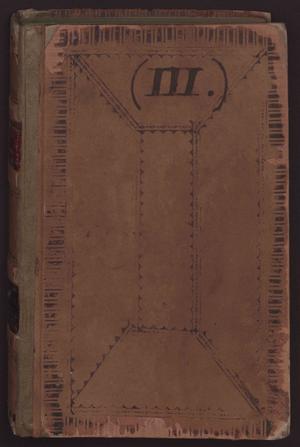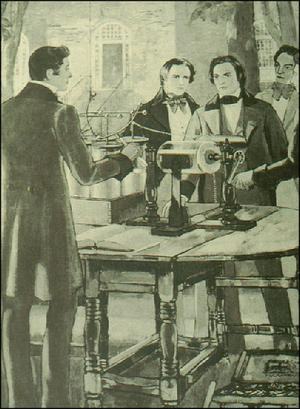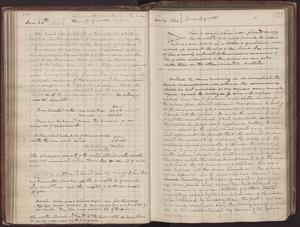Record of Experiments Introduction
 In 1834, Joseph Henry (1797-1879) , an American physicist and first Secretary of the Smithsonian Institution, began to record his scientific research in his "Record of Experiments." Known for his pioneering research in electromagnetism, Henry was also interested in such topics as acoustics, anthropology, geology, lightning and optics. From 1834 to 1863, Henry recorded his research and laboratory experiments at the College of New Jersey, now Princeton University, and later the Smithsonian in three volumes of notebooks. The volumes document his role as an experimental physicist and cover a broad range of subject areas, although the majority of the entries deal with experiments in electricity and magnetism.1
In 1834, Joseph Henry (1797-1879) , an American physicist and first Secretary of the Smithsonian Institution, began to record his scientific research in his "Record of Experiments." Known for his pioneering research in electromagnetism, Henry was also interested in such topics as acoustics, anthropology, geology, lightning and optics. From 1834 to 1863, Henry recorded his research and laboratory experiments at the College of New Jersey, now Princeton University, and later the Smithsonian in three volumes of notebooks. The volumes document his role as an experimental physicist and cover a broad range of subject areas, although the majority of the entries deal with experiments in electricity and magnetism.1
The "Record of Experiments" provides a relatively continuous framework for tracing the direction and scope of Joseph Henry's scientific thinking. These carefully maintained laboratory notes reveal not only the types of research Henry pursued but also the tempo of his scientific life, as he passed through periods of creativity or was sidelined by the responsibilities of teaching and administration. The notebooks also allow the reader to trace the influence of other researchers on Henry, through publications, conversations, letters or viewing demonstrations of their work. The volumes not only served as personal working documents that Henry maintained and consulted during research, but also as a formal, dated record of his experimental accomplishments that would establish the priority of his discoveries in electricity and magnetism. In 1832, had Henry found his major paper on electromagnetic induction had been foreshadowed by Michael Faraday's earlier paper on the same topic. Henry believed his  research has been done over a longer period of time and independently of Faraday, but had no systematic documentation or publication to prove that claim. Thus, in 1834, he initiated a carefully dated and maintained set of laboratory notebook that would record the progress of his research and serve as evidence for similar claims in the future. Henry assured this function as a record of his research by periodically having a representative of the American Philosophical Society witness the most recent entries on his work.2
research has been done over a longer period of time and independently of Faraday, but had no systematic documentation or publication to prove that claim. Thus, in 1834, he initiated a carefully dated and maintained set of laboratory notebook that would record the progress of his research and serve as evidence for similar claims in the future. Henry assured this function as a record of his research by periodically having a representative of the American Philosophical Society witness the most recent entries on his work.2
The Record of Experiments are situated somewhere between a laboratory bench notebook and a formal summary of Henry's work. They were, for the most part, neatly and carefully written, with the stains and tears usually found in notebooks kept at the experiment site. Occasional scraps of paper inserted into the volumes probably served that immediate note-taking function, with the Record completed shortly after the experiment or series of experiments ended. The earlier entries were quite terse and factual. In his later years, Henry's entries were fuller and more reflective on his views of the work at hand. Henry frequently reviewed his past work, making notations in older entries relating them to more recent work, and drawings relationships and conclusions among them.3
THE NOTEBOOKS
 The "Record of Experiments" consists of three manuscript notebooks, measuring approximately 13 x 8 inches, with "Record of Experiments" written on the spine. The notebooks appear to have been used for other purposes prior to being turned to service of Henry's research. For example, volume 1 begins with a set of accounts in an unknown neat clerical hand. Henry's entries began in the middle of the volume, continued to the end, and then picked up again at the beginning of the volume, ending in the middle. The other two volumes follow a regular chronology from front to back. Volume 1 covers Henry's research from August 15, 1834, to September 1839; Volume 2 carries Henry's research forward to 1842; and Volume 3 completes his research through 1863, with some undated notes and a brief index at the end.4 The multi-volume work, The Papers of Joseph Henry, provide extensive annotations for entries in the Record of Experiments and can be consulted for additional information on the context and outcome of Henry's experimental work.5
The "Record of Experiments" consists of three manuscript notebooks, measuring approximately 13 x 8 inches, with "Record of Experiments" written on the spine. The notebooks appear to have been used for other purposes prior to being turned to service of Henry's research. For example, volume 1 begins with a set of accounts in an unknown neat clerical hand. Henry's entries began in the middle of the volume, continued to the end, and then picked up again at the beginning of the volume, ending in the middle. The other two volumes follow a regular chronology from front to back. Volume 1 covers Henry's research from August 15, 1834, to September 1839; Volume 2 carries Henry's research forward to 1842; and Volume 3 completes his research through 1863, with some undated notes and a brief index at the end.4 The multi-volume work, The Papers of Joseph Henry, provide extensive annotations for entries in the Record of Experiments and can be consulted for additional information on the context and outcome of Henry's experimental work.5
The three volumes of the Record of Experiments required significant conservation work prior to digitization; thus, this section will begin with Volume 3, which required the least conservation. Volumes 1 and 2 will be digitized as conservation work is completed.
VOLUMES
Volume 1: August 15, 1834-September 1839
Volume 2: 1839-1842
Volume 3: 1842-1863
FOOTNOTES
1 Nathan Reingold, Stuart Pierson, and Arthur P. Molella, eds., The Albany Years: December 1797-October 1832, vol. 1 of The Papers of Joseph Henry (Washington, DC: Smithsonian Institution Press, 1972), 215. Return to text
2 Ibid., 216-217. Return to text
3 Ibid., 218-219. Return to text
4 Ibid., 219. Return to text
5 Nathan Reingold, et al., eds., The Papers of Joseph Henry , vols. 1-12 (Washington, DC: Smithsonian Institution Press and Science History Publications, 1972-2008). Return to text
